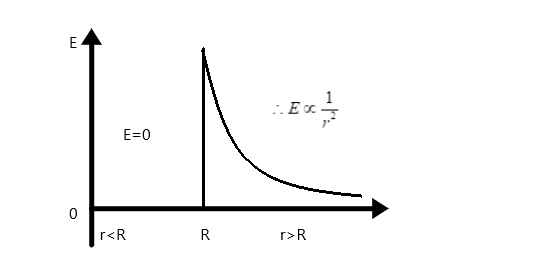
Using Gauss’s law obtain the expression for the electric field due to the uniformly charged thin spherical shell of radius $R$ at a point outside the shell. Draw a graph showing the variation of electric field with $r$, for $r > R$ and $r < R$.
Answer
559.2k+ views
Hint A uniformly charged sphere is spherically symmetric i.e. all points around the sphere are identical. Therefore, choose a spherical Gaussian surface whose radius is equal to the distance$r$ from the center of the sphere.
Formula used: $\oint {\vec E \cdot d\vec A} = \dfrac{{{Q_{enc}}}}{{{\varepsilon _0}}}$ where $\vec E$ is the electric field vector, $d\vec A$ is the infinitesimal area vector, ${Q_{enc}}$ is the charge enclosed in the Gaussian surface and ${\varepsilon _0}$ is the permittivity of free space, $\oint {\vec E \cdot d\vec A} $ is the total flux going through the Gaussian surface.
Complete step by step answer

Gauss law allows us to easily find the electric field of a charge distribution by taking advantage of a possible symmetry in its arrangement. From integral form of Gauss law, we have
$\Rightarrow \oint {\vec E \cdot d\vec A} = \dfrac{{{Q_{enc}}}}{{{\varepsilon _0}}}$
For a uniform spherical charge, the equation becomes
$\Rightarrow E \times A = \dfrac{{{Q_{enc}}}}{{{\varepsilon _0}}}$ because the electric fields flowing through every infinitesimal area of our Gaussian surface are equal.
Then,
$\Rightarrow E \times 4\pi {r^2} = \dfrac{{{Q_{enc}}}}{{{\varepsilon _0}}}$ (since $A = 4\pi {r^2}$)
Rearranging for $E$, we get
$\Rightarrow E = \dfrac{{{Q_{enc}}}}{{4\pi {\varepsilon _0}{r^2}}}$
$\therefore E \propto \dfrac{1}{{{r^2}}}$
The electric field for a uniformly charged thin spherical shell at radius $r < R$ is zero (since there would be no charge enclosed).
Hence, the graph of electric field with distance is as shown below.

Note
For $r < R$ we said that this is due to the fact that there would be no charged enclosed. For further understanding consider the constant form of Gauss’s law
$\Rightarrow E \times A = \dfrac{{{Q_{enc}}}}{{{\varepsilon _0}}}$
For $r < R$, we pick a Gaussian surface that is inside the spherical shell. Since the charges are distributed around the shell, the charge enclosed by the Gaussian surface is zero, i.e. $\Rightarrow {Q_{enc}} = 0$. Hence, from
$\Rightarrow E \times A = \dfrac{{{Q_{enc}}}}{{{\varepsilon _0}}} $
$\Rightarrow E = 0 $
Also, $E$ is maximum at $r = R$ because ${Q_{enc}} = \sigma 4\pi {R^2}$ where $\sigma $ is the surface charge density. Thus, from $E = \dfrac{{{Q_{enc}}}}{{4\pi {\varepsilon _0}{r^2}}}$ we replace ${Q_{enc}}$ as $\sigma 4\pi {R^2}$. Then, we have
$\Rightarrow E = \dfrac{{\sigma 4\pi {R^2}}}{{4\pi {\varepsilon _0}{r^2}}}$.
For $r = R$,
$\Rightarrow E = \dfrac{\sigma }{{{\varepsilon _0}}}$
Formula used: $\oint {\vec E \cdot d\vec A} = \dfrac{{{Q_{enc}}}}{{{\varepsilon _0}}}$ where $\vec E$ is the electric field vector, $d\vec A$ is the infinitesimal area vector, ${Q_{enc}}$ is the charge enclosed in the Gaussian surface and ${\varepsilon _0}$ is the permittivity of free space, $\oint {\vec E \cdot d\vec A} $ is the total flux going through the Gaussian surface.
Complete step by step answer

Gauss law allows us to easily find the electric field of a charge distribution by taking advantage of a possible symmetry in its arrangement. From integral form of Gauss law, we have
$\Rightarrow \oint {\vec E \cdot d\vec A} = \dfrac{{{Q_{enc}}}}{{{\varepsilon _0}}}$
For a uniform spherical charge, the equation becomes
$\Rightarrow E \times A = \dfrac{{{Q_{enc}}}}{{{\varepsilon _0}}}$ because the electric fields flowing through every infinitesimal area of our Gaussian surface are equal.
Then,
$\Rightarrow E \times 4\pi {r^2} = \dfrac{{{Q_{enc}}}}{{{\varepsilon _0}}}$ (since $A = 4\pi {r^2}$)
Rearranging for $E$, we get
$\Rightarrow E = \dfrac{{{Q_{enc}}}}{{4\pi {\varepsilon _0}{r^2}}}$
$\therefore E \propto \dfrac{1}{{{r^2}}}$
The electric field for a uniformly charged thin spherical shell at radius $r < R$ is zero (since there would be no charge enclosed).
Hence, the graph of electric field with distance is as shown below.

Note
For $r < R$ we said that this is due to the fact that there would be no charged enclosed. For further understanding consider the constant form of Gauss’s law
$\Rightarrow E \times A = \dfrac{{{Q_{enc}}}}{{{\varepsilon _0}}}$
For $r < R$, we pick a Gaussian surface that is inside the spherical shell. Since the charges are distributed around the shell, the charge enclosed by the Gaussian surface is zero, i.e. $\Rightarrow {Q_{enc}} = 0$. Hence, from
$\Rightarrow E \times A = \dfrac{{{Q_{enc}}}}{{{\varepsilon _0}}} $
$\Rightarrow E = 0 $
Also, $E$ is maximum at $r = R$ because ${Q_{enc}} = \sigma 4\pi {R^2}$ where $\sigma $ is the surface charge density. Thus, from $E = \dfrac{{{Q_{enc}}}}{{4\pi {\varepsilon _0}{r^2}}}$ we replace ${Q_{enc}}$ as $\sigma 4\pi {R^2}$. Then, we have
$\Rightarrow E = \dfrac{{\sigma 4\pi {R^2}}}{{4\pi {\varepsilon _0}{r^2}}}$.
For $r = R$,
$\Rightarrow E = \dfrac{\sigma }{{{\varepsilon _0}}}$
Recently Updated Pages
A man running at a speed 5 ms is viewed in the side class 12 physics CBSE

The number of solutions in x in 02pi for which sqrt class 12 maths CBSE

State and explain Hardy Weinbergs Principle class 12 biology CBSE

Write any two methods of preparation of phenol Give class 12 chemistry CBSE

Which of the following statements is wrong a Amnion class 12 biology CBSE

Differentiate between action potential and resting class 12 biology CBSE

Trending doubts
What are the major means of transport Explain each class 12 social science CBSE

Which are the Top 10 Largest Countries of the World?

Draw a labelled sketch of the human eye class 12 physics CBSE

Explain sex determination in humans with line diag class 12 biology CBSE

Explain sex determination in humans with the help of class 12 biology CBSE

Differentiate between homogeneous and heterogeneous class 12 chemistry CBSE




